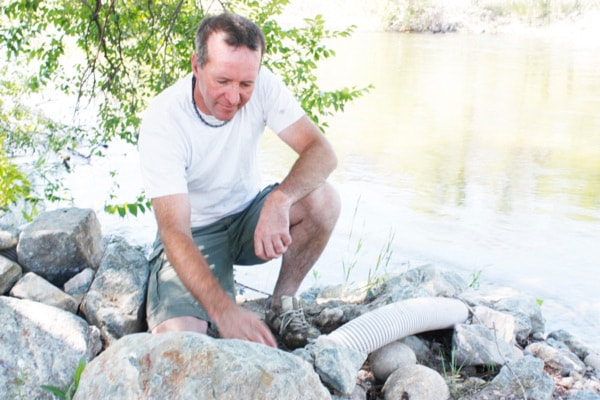An Oliver farm’s irrigation troubles have the region’s MP reaching out to the provincial government for a solution.
Alex Atamanenko, NDP MLA for B.C.’s Southern Interior riding wrote a letter last week to B.C.’s agriculture minister, Don McRae requesting the province’s intervention in saving a farm in Oliver which its owners say is facing closure after a new water intake system was installed by the Okanagan River Restoration Initiative, or ORRI.
The restoration initiative is a plan to restore fish and wildlife habitats on the Okanagan River. The initiative has many different partners, including the Ministry of Forests, Lands and Natural Resource Operations and the Okanagan Nation Alliance.
“Before 2009 things were well, things were fine, all of a sudden this project rolls in and he’s in a bind, he can’t do anything, and nobody seems to be really, he’s approached other people before and nobody seems to be doing anything,” said Atamanenko
Gordon Forbes, who owns the farm with his brother, said the financial cost of the irrigation problems have been drastic.
“I would say we’re getting up to at least $60-$80,000 over the last couple of years, not including my time as I’m working for free,” said Forbes. “We’ve actually had to hire additional staff now, because I have to go and keep the irrigation going.”
He said that he spends two hours a day cleaning out his high-efficiency irrigation system, which easily plugs with the large amounts of sediment the new intake brought in.
Forbes and his neighbouring farmer Art Dias went so far as to recently bypass the new intake, instead relying on a temporary intake closer to the bank. Dias said his farm wasn’t seeing the same issues as the Forbes farm, as he uses a less-efficient water system which allows sediment to pass through.
In 2009, the piece of river Forbes and Dias used for drawing irrigation was altered by ORRI. Due to the changes that were happening to the farm’s intake area, Kari Alex, a co-ordinator for the restoration initiative’s steering committee, said it was their responsibility to ensure that the Forbes’ intake system was “the same or better than what he had before.”
To this end, the contractor, Mould Engineering, put in an intake system further away from the bank that sits at the bottom of the river in 2010. When this system wasn’t working, the river initiative allowed Forbes to pick his own irrigation specialist to examine the system and make it work. The new system was installed in 2011, and after another unproductive year Forbes requested that ORRI install a well he said he was initially promised. Forbes said after receiving little to no attention from ORRI or Mould Engineering, he was forced to turn to asking politicians and authorities for help.
However, Jody Good, an engineer with Mould, said while Forbes initially requested a well, a study was done that found a number of reasons a well wouldn’t be feasible for the farms. Good said data from other wells in the area show the well wouldn’t be able to sustain both Forbes and Dias’ farms, that there was a high possibility of sediment being brought through the system and lastly, the cost associated with the well was too high. After installing the first intake system in 2010, Mould Engineering hasn’t been involved with initiative.
Alex, the co-ordinator from the restoration initiative, said that the intake system isn’t to blame for the Forbes’ irrigation issues.
“The problem that they are having is consistent throughout the valley, when you have these high flows, they carry alot of sediment. Sediment is really hard on high-effeciency water farms like drip irrigation,” she said.
Alex added that after modifications were made in 2011, a nearly $10,000 sand filter was given to the Forbes to be installed on the lines of both farms; however Forbes only installed the filter on his farm, which not only caused tension with his neighbour, but Alex said it may also be contributing to the difficulties he is having with his irrigation lines.
“It wasn’t installed where the specialist had meant for it to be installed to work at its maximum capacity,” said Alex. In a memo from Alex on July 9, Alex said there would be “no further allocations of funds and (personnel) related to the intake and water system,” although the initiative would remain in contact with the Forbes and Dias farms.
In an email, a spokesperson from the Ministry of Forests, Lands and Natural Resource Operations, one of the partners in the river initiative, said the issues Mr. Forbes has been experiencing are primarily related to the high water flows over the last two seasons, not the work done on the channel. However, the B.C. government and the Okanagan Nation Alliance would continue to work on solutions for the farms, such as a possible well for the Forbes farm.
